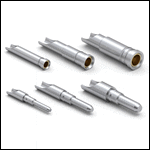How to Specify Mini-SAS HD Connectors and Cable Assemblies
There are a number of variables to consider when choosing Mini-SAS HD interconnects, and here TE offers tips on how to specify Mini-SAS HD connectors and cable assemblies to achieve the necessary performance level.
† Serial Attached SCSI (SAS) connectors are essential for interconnecting storage systems in the data center. SAS defines the standard interconnect in a piece of storage equipment. The standard has evolved over the years, from SAS-1 at 3.0 Gigabits per second (Gb/s) in 2005, to SAS-2 at 6Gb/s in 2009, to SAS-3, which delivers 12Gb/s and was introduced in 2013. Mini-SAS HD (high density) connectors and cable assemblies comply with the SAS-3 standard.
Serial Attached SCSI (SAS) connectors are essential for interconnecting storage systems in the data center. SAS defines the standard interconnect in a piece of storage equipment. The standard has evolved over the years, from SAS-1 at 3.0 Gigabits per second (Gb/s) in 2005, to SAS-2 at 6Gb/s in 2009, to SAS-3, which delivers 12Gb/s and was introduced in 2013. Mini-SAS HD (high density) connectors and cable assemblies comply with the SAS-3 standard.
Mini-SAS HD connectors and cable assemblies support both internal and external applications. In addition to storage, Mini-SAS HD connectors are used in some types of industrial and medical equipment. Internal connections can link server processors with built-in storage systems, while external versions connect storage disks or other devices from shelf to shelf or rack to rack.
To specify a Mini-SAS HD connector or cable assembly, several variables must be considered, including the number of ports on the connector, the gauge of wire in a cable assembly and the length of the cable, the type of cable in a cable assembly, the latch design (on external cable assemblies), and the manufacturing lead time. There are also specific performance criteria that you’ll want to achieve.
Number of Ports
Designers choose different numbers of ports in a Mini-SAS HD connector depending on the data throughput required. There are four lanes in a Mini-SAS HD connector system, and each lane is 12Gb/s. Therefore, a single port delivers 48Gb/s. Customers who want to move more data more quickly would use connector designs with more ports. There are single-port, dual-port, and four-port designs available. In the storage industry, you’ll see a 1U-size storage shelf loaded with ports, because it’s all about moving data from servers and switches. In an industrial or medical piece of equipment, the connector would probably have fewer ports because you’re usually not moving as much data.
Cable Length and Wire Gauge
Additional criteria include cable length and wire gauge. Not only does SAS define the connector’s form factor, it also defines the performance. The SAS standard defines how a cable assembly will perform in terms of insertion loss, cross talk, and other factors that degrade the signal. Mini-SAS HD cable assemblies are generally available in four different wire gauges: 30, 28, 26, and 24; the lower the number, the larger the conductor diameter. With a larger conductor diameter, the cable assembly will generally meet the industry specification at longer distances – there is less attenuation because the conductor is larger. For example, a 30-gauge cable would be about three meters long, while a 24-gauge cable might be 6 – 7 meters long and still meet the industry specification.
Customer Criteria
Customers often have their own connector and cable assembly performance requirements. Based on the loss budget of a channel, they might need to go up a gauge on the wire size for a cable assembly for a better performance margin. The basic performance is defined by the industry standard, but customers decide what they will actually use based on how the system is configured. Connector manufacturers are often given a loss budget by the customer – a customer may have a loss budget of 10dB over a distance of three meters, and the manufacturer might say the customer needs to use 26-gauge wire in a cable assembly to accommodate that loss budget.
Cable Type
External connectors use round cables, while internal cables often use a flat twinax cable to save some space inside the system. However, some designers prefer a round cable on internal cable assemblies.
Latch Design
Some cable assemblies for external connectors have more robust latching mechanisms than others. When a latch design has a higher latch retention force, it is less likely to come unplugged when a storage system or other device is moved.
Manufacturing Lead Time
Lead time between order placement and delivery should be considered and discussed with manufacturers, especially with custom-built orders. Lead times for Mini-SAS HD connectors and cable assemblies can vary depending on the manufacturer and the parts ordered. Be sure to communicate delivery expectations early as a part of specification requirements.
Mini-SAS HD connectors and cable assemblies are choice components for storage applications. They deliver high performance in a small form factor that allows systems manufacturers to add a lot of ports to a piece of equipment. By considering the above criteria, system designers can find the right Mini-SAS HD connector for any storage application.
Co-author Melissa Knox is product manager for I/O products in TE Connectivity’s Data and Devices division.
Co-author Scott Kleinle is global director of cable and cable assembly at TE Connectivity.








